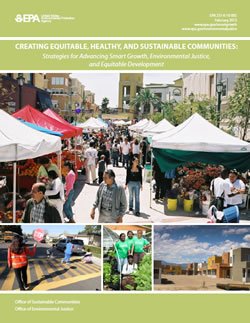Smart Growth and Equitable Development
On other pages:
- Equitable Development and Environmental Justice
- Environmental Justice Grants, Funding and Technical Assistance
- EPA Engagement with Energy Communities
- Resources for Creating Healthy, Sustainable and Equitable Communities
Background

Every community - no matter its size, location or composition - has its own unique history and cultural assets. Underserved and vulnerable communities, in particular, have often established strong social networks and local knowledge that provide a strong foundation for equitable and inclusive community development.
Many of these internal bonds are especially important in light of the challenges that these communities may face, including proximity to polluting facilities, barriers to participating in decision-making processes, disproportionate levels of chronic diseases, neighborhood divestment and poor or no access to jobs and services. Many of these challenges are direct outcomes of how communities and regions are planned and built.
Smart growth can help address long-standing environmental, health, and economic disparities and facilitate community-driven solutions, through land use and development practices that:
- Reinvest in neighborhoods, clean up and reuse contaminated properties.
- Provide housing choices for people of all income levels, household sizes, and stages of life.
- Offer transportation options that are affordable, reduce air pollution and associated health impacts, and give residents who do not drive more mobility.
- Improve access to jobs and services by creating development that is walkable and transit-accessible.
Equitable development approaches create healthy and vibrant communities and regions, where residents of all incomes, races, and ethnicities participate in and benefit from decisions that shape the place where they live.
Equitable development posits that the public has the right to inform inform decisions that could affect their environment and health. Decision-makers, including those at regulatory agencies, should seek out and facilitate the engagement of those potentially affected by their decisions and take their contributions into account.
Technical Assistance
EPA's Office of Community Revitalization has offered the following current and recent planning assistance, grounded in inclusive community engagement practices, to support communities in equitable development:
- Building Blocks for Sustainable Communities.
- Community Change Equitable Resilience.
- Local Foods, Local Places.
- Recreation Economy for Rural Communities.
Community Projects
EPA developed reports from several past technical assistance projects that may inform communities in their own equitable development journey.
- Managing Vacant and Abandoned Property in the Green Zone of Saginaw, Michigan (2014): EPA worked with the community of Saginaw to identify options for developing a land use and infrastructure strategy that stabilizes neighborhoods through the sustainable reuse of abandoned properties, supports redevelopment of abandoned properties as green infrastructure, and creates opportunities for long-term economic growth. The final report provides information useful to any community seeking to return vacant and abandoned properties to productive use in a sustainable and economically resilient way.
- Public Involvement Plan and Toolkit for Las Cruces, New Mexico (2011): This Smart Growth Implementation Assistance project developed strategies to improve public engagement in community planning and design processes, focusing on ethnically diverse, low-income populations and others who have traditionally had limited involvement in decision-making.
Data, Policy and Tools
- White House Policy Directive to Federal Agencies to Advance Urban Equitable Development (2023): In 2023, the Biden-Harris administration released a policy memorandum pursuant to a key provision in President Biden's Executive Order on Further Advancing Racial Equity and Support for Underserved Communities Through the Federal Government (Executive Order 14091), which directs agencies to undertake efforts, consistent with applicable law, to strengthen urban equitable development policies and practices.
- Attracting Infill Development in Distressed Communities: 30 Strategies (2015): Helps communities determine their readiness to pursue infill development and identify strategies to better position themselves to attract infill development.
-

- Equitable Development Principles and Scorecard (The Alliance, 2022): Establishes a framework for equitable development that creates a more holistic, community-driven decision-making processes aimed at ameliorating the effects of past harmful policies and development on marginalized communities.
-
Localized Anti-Displacement Policies (Center for American Progress, 2022): Details the process of displacement and gentrification that may arise when governments make new investments in communities. It also offers an array of policy tools and other solutions to address it.
-
The Housing and Transportation Affordability (H+T®) Index (The Center for Neighborhood Technology): This tool calculates and maps location affordability based on combined housing and transportation costs.
-
The Ingredients of Equitable Development Planning: A Cross-Case Analysis of Equitable Development Planning and CDFIs (Join Center for Housing Studies of Harvard University, 2019): This report provides analysis of three equitable development campaign case studies from across the U.S. Each centers around a nonprofit community development financial institution (CDFI) and their efforts to spur equitable development through strategic capital investment and the formation of key community partnerships.
-
Equitable Development as a Tool to Advance Racial Equity (Government Alliance on Race and Equity, 2015): This publication outlines a policy framework that promotes greater racial equity through the implementation of equitable development strategies.
-
Equity Tools (PolicyLink): Provides descriptions, benefits, implementation recommendations, potential challenges, possible funding sources, and case studies for tools that can help create vibrant and healthy neighborhoods, prevent displacement, and promote equitable revitalization.
